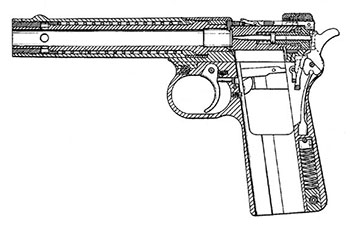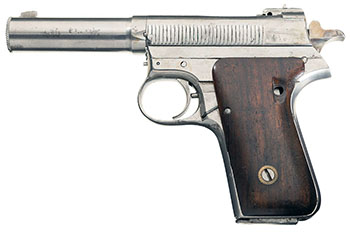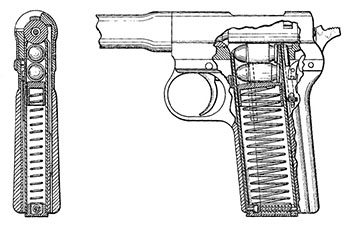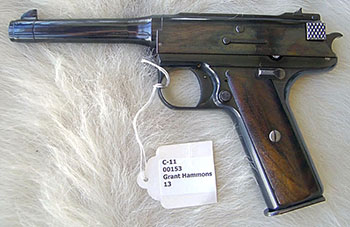 |
|||||||||||||||||||||||||||||||||||||||||||||||||||||||||||||||||||||||||||||||||||||||||||||||||||||||||||||||||||||||||||||||||||||||||
|
The Grant Hammond Automatic Pistol Grant Hammond was a chemist, engineer, and inventor who was born in San Francisco on 14 August 1868. Apparently Hammond worked for Winchester during the same period of time as Gus Swebelius, who later purchased the Hartford Arms and Equipment Company and renamed it High Standard. In 1917 and 1918, Grant Hammond was at least part owner of the Grant Hammond Manufacturing Company, which was engaged in the production of parts for the Liberty aircraft engine in New Haven, Connecticut. We can probably interpolate here that since everyone involved in U.S. manufacture at the time was getting government contracts, Hammond was actively seeking a government contract to manufacture his pistol design. He was already manufacturing parts under what was almost certainly a government contract or subcontract. Available historical evidence includes the remaining prototype pistols (said to number no more than 18), a number of U.S. patents, and various records of the U.S. Ordnance Department.
The gas operated pistol that appears in Hammond’s first two patents is quite complex. At least one prototype was manufactured, and it looks very much like the patent drawing. The gun was chambered for the .32 ACP, though I suspect this was simply an expedient in a proof-of-concept gun, since the .32 cartridge doesn’t require a locked breech mechanism. The gun has a barrel casing which contains the gas from the burnt propellant.
But during the same period, Hammond was also developing another pistol design for the .45 ACP cartridge that was somewhat less complex, but retained the fixed barrel concept with a reciprocating bolt (albeit one that did not lock by rotating) and a self-ejecting magazine. This is the pistol for which he sought to obtain a military contract, and of which there are a dozen or so known prototypes. The breech was locked by a single plunger on the underside of the bolt which interfaced with a lug on the frame just behind the magazine. The bolt is retracted by two checkered extensions on its rear face. The gun has something analogous to a slide, which R.K. Wilson refers to as a barrel extension, which does not have nearly the range of motion of a true slide, and which is held in its forward position by a short return spring just above the trigger guard. When the gun is fired, this barrel extension recoils for a short distance with the bolt. During this short recoil, the bullet leaves the barrel.
Sometime in 1917 Grant Hammond Manufacturing contacted the Chief of Ordnance to request a test of their new pistol, which they claimed was superior to the Colt Model 1911. Major J. T. Kenyon, Chief Inspector of Small Arms, detailed Major Charles F. Armstrong, Assistant Chief Inspector of Small Arms at the Winchester plant, to visit the Grant Hammond facility and report on the pistol.
The Hammond pistol was tested again on 18 January 1918 at the Springfield Armory. The pistol was disassembled and reassembled, and the times were noted. Ten rounds were fired from a rest at 15 yards and the mean radius of the of the resulting bullet holes was 0.9 inches. However, in firing those ten shots there were five failures to load and one failure to feed. Four attempts were made to fire four magazines in a row (32 rounds) with no failures, but it could not be done and Hammond was forced to withdraw the pistol. He presented the gun for an endurance test on 16 March 1918. A total of 5000 rounds were fired, and the barrel was allowed to cool after every 50 rounds. 154 malfunctions were noted. Two firing pins were broken, the locking bolt plunger broke, and the extractor spring had to be replaced. Hammond withdrew the gun again before further testing could be completed. The Army tested the gun one last time at Camp Perry, after Hammond had modified the magazine release mechanism so that it did not eject the empty magazine but instead dropped it down a couple of inches for easy withdrawal. No record exists of the results of the Camp Perry test, but apparently they were not good.
The Grant Hammond .45 showed great promise because of its accuracy, but important parts broke on a regular basis, including the locking cam, the locking bolt plunger, and the firing pin, and the gun experienced regular failures to lock, feed, and eject. The magazine was temperamental as well. It remained an experimental gun and never attained the reliability of a true production weapon. There are two known examples of a High Standard .45 automatic pistol prototype that are quite similar to one of the last of the Grant Hammond prototypes. It is probable that Hammond took the design to his friend Gus Swebelius in the hope that he could turn it into a viable commercial product. One gun, pictured in Petty’s book, is believed to have a barrel and barrel extension adapted from original Grant Hammond parts. The gun is unmarked. The other gun, pictured in Meadows’ book, is marked “MADE BY THE HIGH STANDARD MFG. CO. / NEW HAVEN, CONN. / UNITED STATES OF AMERICA / .45 CAL. / PAT. PENDING”. Apparently, High Standard was unable to work out the bugs in the gun, as it was never manufactured commercially.
|
|||||||||||||||||||||||||||||||||||||||||||||||||||||||||||||||||||||||||||||||||||||||||||||||||||||||||||||||||||||||||||||||||||||||||
|
Copyright 2008 by Ed Buffaloe. All rights reserved. |
|||||||||||||||||||||||||||||||||||||||||||||||||||||||||||||||||||||||||||||||||||||||||||||||||||||||||||||||||||||||||||||||||||||||||
|
|||||||||||||||||||||||||||||||||||||||||||||||||||||||||||||||||||||||||||||||||||||||||||||||||||||||||||||||||||||||||||||||||||||||||
|
|
|||||||||||||||||||||||||||||||||||||||||||||||||||||||||||||||||||||||||||||||||||||||||||||||||||||||||||||||||||||||||||||||||||||||||




